
Hasegawa 1/48 P-40N Warhawk
| KIT #: | JT 88 |
| PRICE: | $29.95 MSRP |
| DECALS: | Two options |
| REVIEWER: | Tom Cleaver |
| NOTES: |

| HISTORY |
Throughout its career, the P-40 suffered from a high weight-to-power ratio,
and was several times the subject of “weight reduction” programs that would
manage to pare off perhaps as much as 100 pounds, but with little real
improvement in performance. The major production version of the P-40 - the
P-40N - began its life as a result of the second major weight reduction
program. The early P-40N-1 was armed with only four .50 caliber machine
guns. The front wing tank was removed, and aluminum oil coolers and
radiators were used, as well as using smaller, lighter wheels, for a total
combat weight of 8,850 lbs. Powered by the Allison V-1710-81 engine, which
reduced power to 1,200 h.p. but increased altitude rating to 17,800, the
result was an increase in maximum speed to 378 m.p.h., fastest of the
series. After less than 200 had
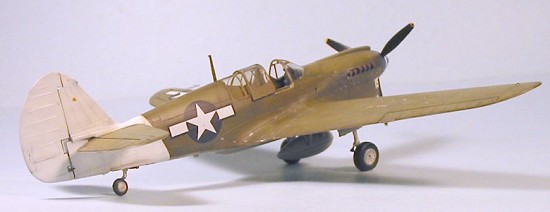 been produced, the two machine guns and
the 137 gallon wing tank was restored, raising the weight to 11,400 lbs.
Beginning with the P-40N-5, the original canopy was replaced by a frameless
hood, with a deeper rectangular aft section to improve view. The most
widely-built version was the P-40N-20, which saw a production run of 3,022
aircraft. By the time production of the P-40 ended in 1944, more than
14,000 of all variants had been delivered and the airplane had seen active
service on every front and been flown by air forces on both sides.
been produced, the two machine guns and
the 137 gallon wing tank was restored, raising the weight to 11,400 lbs.
Beginning with the P-40N-5, the original canopy was replaced by a frameless
hood, with a deeper rectangular aft section to improve view. The most
widely-built version was the P-40N-20, which saw a production run of 3,022
aircraft. By the time production of the P-40 ended in 1944, more than
14,000 of all variants had been delivered and the airplane had seen active
service on every front and been flown by air forces on both sides.
Curtis LeMay said the battle for air superiority over Tokyo was won in the skies of New Guinea. Japanese pilots had a saying: "No one ever returns alive from New Guinea." The Japanese Army Air Force pilots called New Guinea “the graveyard of pilots,” which gives an indication of the long and hard-fought air battles that occurred over the largest island in the Pacific from early 1942 until the Japanese were finally driven out in the summer of 1944. An indication of what the Fifth Air Force achieved in this struggle came when U.S. Navy carrier planes raided the Philippines in August and September, 1944. Opposition was so light that Rear Admiral Robert Carey - Chief of Staff to Admiral William Halsey - wrote to MacArthur’s Chief of Staff, General Richard Sutherland that General George Kenney’s pilots had “just about spoiled the war for our carriers.”
One of the organizations most responsible for this was the 49th Fighter Group, the first organized American fighter unit to enter the Pacific War after the attack on Pearl Harbor. By the fall of 1942, the Japanese threat to Australia had receded and the front line of the war in the southwest Pacific was New Guinea. The 49ers began operating on the big island that fall, with squadrons rotating through Port Moresby while at least one squadron maintained fighter defense for northern Australia at Darwin.
 The 9th Fighter Squadron was re-equipped with P-38s in early
1943, as General Kenney tried to have at least one squadron in each of his
P-39 and P-40-equipped fighter groups equipped with what he considered the
best fighter available. The 7th and 8th Squadrons
transferred full-time to New Guinea in March 1943.
The 9th Fighter Squadron was re-equipped with P-38s in early
1943, as General Kenney tried to have at least one squadron in each of his
P-39 and P-40-equipped fighter groups equipped with what he considered the
best fighter available. The 7th and 8th Squadrons
transferred full-time to New Guinea in March 1943.
In fighting through the Western Pacific from 1942-45, The 49th Fighter Group scored 668 confirmed air-to-air kills. 313 of these went to pilots in P-40s, fighting over New Guinea.
Many of the 49th FG pilots liked the P-40, even though its performance was not up there with the P-38 and P-47 that equipped other units. One such pilot was Lieutenant Robert DeHaven, who left Washington and Lee University in February 1942 to join the Army Air Corps. Earning his wings that summer, he was assigned to P-40 training in Florida and was sent to Hawaii in February 1943, then on to Port Moresby, New Guinea via Australia in May, where he flew with the P-40-equipped 7th Fighter Squadron at Dobodura. DeHaven’s arrived in the group at about the same time the P-40N replaced the unit’s tired P-40Es and P-40Ks.
DeHaven scored his first victory on July 14, 1943 and his fifth on December 10. He participated in the offensives that took Buna, Lae, the Markham Valley, Hollandia and Biak Island by the summer of 1944. His score during this period of 10 enemy aircraft was one of the highest P-40 scores for USAAF pilots. Surprisingly, DeHaven preferred the P-40 over the P-38. In “Fire in the Sky: The Air War in the South Pacific,” DeHaven explains:
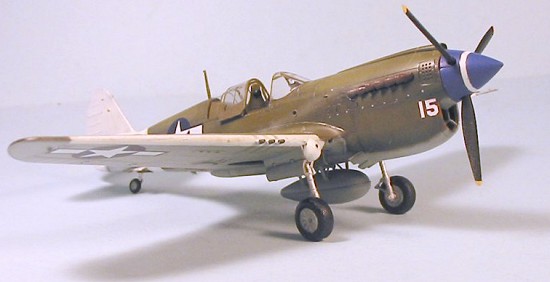 “After training I requested duty in the Pacific and I requested being
posted to a P-40 squadron and both wishes were granted. This was early in
1943 and most pilots already desired more advanced types and some thought
my decision a mistake. Yet I had been inspired by the deeds of the Flying
Tigers. We had also heard accounts that the P-38 was difficult to bail out
of because of its twin-boom tail and that it was difficult when flying with
one engine. I also knew that P-38s were still rare in the theater and I
wanted to get into the war as soon as possible. That wish, too, was
granted. I never regretted the choice.
“After training I requested duty in the Pacific and I requested being
posted to a P-40 squadron and both wishes were granted. This was early in
1943 and most pilots already desired more advanced types and some thought
my decision a mistake. Yet I had been inspired by the deeds of the Flying
Tigers. We had also heard accounts that the P-38 was difficult to bail out
of because of its twin-boom tail and that it was difficult when flying with
one engine. I also knew that P-38s were still rare in the theater and I
wanted to get into the war as soon as possible. That wish, too, was
granted. I never regretted the choice.
“If you flew wisely, the P-40 was a very capable aircraft. In many conditions, it could out turn a P-38, a fact that some pilots didn’t realize when they made the transition between the two aircraft. The P-40 kept me alive and allowed me to accomplish my mission. The real problem with it was lack of range. As we pushed the Japanese back, P-40 pilots were slowly left out of the war. So when I moved to P-38s, an excellent aircraft, I did so not because I believed that the P-40 was an inferior fighter, but because I knew the P-38 would allow us to reach the enemy. I was a fighter pilot and that was what I was supposed to do.”
Following the invasion of Biak, the 7th Fighter Squadron transitioned to P-38s in July-September 1944 for the Philippine invasion, and the 49ers became an all-P-38 outfit.
| THE KIT |
As to what’s in the box, read Scott’s preview.
The P-40N has been previously done in 1/48 by AMT and Mauve, with the Mauve kit being the better of the two in terms of surface detail and look when completed. Both of these kits were in desperate need of a resin cockpit, which is available for the P-40N from True Details and is one of the best, having been created by “Mr. Cockpit,” Scott Battistoni. This kit looks better with a resin cockpit, but what’s provided in the box will look good with the addition of seat belts, as I found when I built my model.
| CONSTRUCTION |
There is really not much else to say about assembling the Hasegawa P-40s beyond what I said in my other reviews.
The secret to the assembly, since the kit has so many “plug in” parts, is
careful fitting of those parts, so that you get a good fit and the seams
that are created can be filled to get a smooth final surface. I assemble
the tail to the forward fuselage in halves, before gluing the fuselage
halves together, so I can work the fit of the parts from both inside an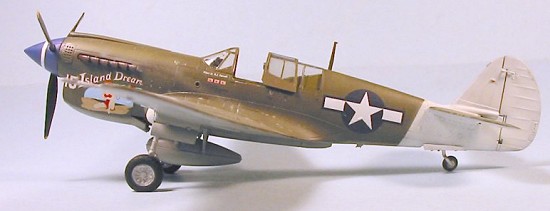 d
outside, to get a smooth fit, which I sand with a sanding stick before and
after covering the seam with Mr. Surfacer 500. It’s also important to get
the fit of the gun plugs in the wings to obtain a smooth surface in that
area. Once these items are attended to, the rest of the assembly is easy.
d
outside, to get a smooth fit, which I sand with a sanding stick before and
after covering the seam with Mr. Surfacer 500. It’s also important to get
the fit of the gun plugs in the wings to obtain a smooth surface in that
area. Once these items are attended to, the rest of the assembly is easy.
This time, I used the kit cockpit, which resulted in a nice-looking cockpit, with Cutting Edge resin seat belts for the final touch. I would recommend using the True Details P-40N resin cockpit, which was designed for the Mauve kit, and would therefore fit this kit with only a little modification to the floor part, since the Hasegawa kit wouldn’t need that part to also double as the inner wall of the wheel well.
The one thing Hasegawa did wrong was not to provide smaller wheels. The P-40N uses the same wheel as the P-51, which is smaller in diameter than the “standard” P-40 wheel of the earlier sub-types. I used P-51 wheels from the spares box on this model.
| COLORS & MARKINGS |
Painting:
I first applied pre-shading to the model, airbrushing flat black over all the panel lines, before proceeding.
I used a very thinned Flat White for the tail and wing leading edge, so it
would give a “ragged” appearance over the black. While regulations called
for the entire tail surface t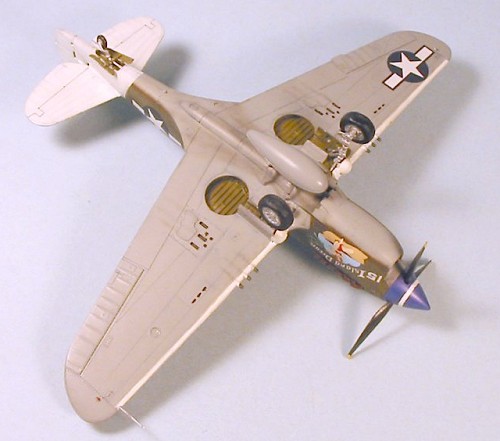 o be painted white, the 49th FG
kept the upper surfaces of the horizontal stabilizer in Olive Drab for
camouflage purposes since the airplanes were based on forward airfields and
subject to ground attack by Japanese aircraft. Once these areas were dry,
they were masked with Tamiya tape, a product I have recently started using
and really like.
o be painted white, the 49th FG
kept the upper surfaces of the horizontal stabilizer in Olive Drab for
camouflage purposes since the airplanes were based on forward airfields and
subject to ground attack by Japanese aircraft. Once these areas were dry,
they were masked with Tamiya tape, a product I have recently started using
and really like.
This was the first time I used the Xtracrylix ANA 613 Olive Drab paint. Finally, someone has gotten this color right! Seeing “Glacier Girl” during her visit to Chino last October was a revelation about the real colors for both Olive Drab and Neutral Grey, since the restorers had matched these colors to the originals on the airframe. Xtracrylix have gotten both of these colors right. ANA 613 OD - the color used for most of the war by the USAAF - is based on World War I British P.C.10, and is a green-base Olive Drab. Neutral Grey is much lighter than the colors provided from other companies. Xtracrylix also has a “Faded Olive Drab” color, which is the color as faded-out as it could be from sunlight. I applied the original color to the model, then added in a bit of “Faded Olive Drab” as I went back over the surfaces, adding in more as I went for lighter and lighter shades on the upper wings and upper fuselage and upper stabilizers. The result is, I think the most-accurate OD-Grey scheme I have done on a model, and I highly recommend these colors to you.
The spinner was painted with Xtracrylix British Blue, since the 49th FG used available paints in Australia for their squadron colors.
Decals:
After applying a coat of Future, I used the Three Guys Replicas decals to do “Island Dream” of the 7th Squadron. These are the most accurate decals available for 49th FG P-40Ns, and the instructions provide in-depth information about why previous markings and camouflage call-outs have been based on incorrect information about these airplanes. I highly recommend the sheet, if for no other reason than to have this information at hand. The decals are printed by Micro-Scale and went on without problem.
| FINAL CONSTRUCTION |
I gave the model an overall coat of Xtracrylix Satin Varnish, then weathered it with exhaust stains and “dings” to the paint. I then applied two coats of Xtracrylix Flat Varnish to get the tropical sun-faded finish I was going for.
I attached the landing gear and doors and the prop, and unmasked the canopy. The sliding portion can be positioned open, but I would personally use a Falcon/Squadron P-40N vac canopy for a future model, since the thinner canopy will look more accurate.
| CONCLUSIONS |
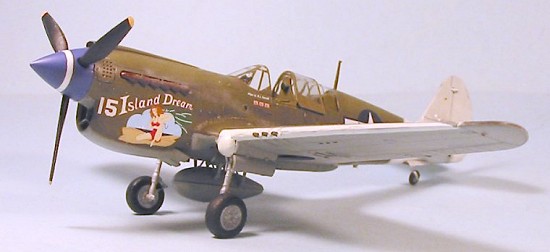 Out of the box, with no additional add-ons other than corrected wheels and
seat belts, the Hasegawa P-40N looks great and continues the tradition
founded by the P-40E of being the most accurate P-40N kit available in any
scale. Given the many different air forces the P-40N flew with - for which
there are numerous decal sheets available - the kit can be made into any
number of attractive schemes. I know I will be using one of my Red Roo
sheets to do an 80 Wing RAAF Kittyhawk IV sometime soon.
Out of the box, with no additional add-ons other than corrected wheels and
seat belts, the Hasegawa P-40N looks great and continues the tradition
founded by the P-40E of being the most accurate P-40N kit available in any
scale. Given the many different air forces the P-40N flew with - for which
there are numerous decal sheets available - the kit can be made into any
number of attractive schemes. I know I will be using one of my Red Roo
sheets to do an 80 Wing RAAF Kittyhawk IV sometime soon.
July 2005
Copyright ModelingMadness.com
Thanks to HobbyLink Japan for the review kit
If you would like your product reviewed fairly and fairly quickly, please contact the editor or see other details in the Note to Contributors.